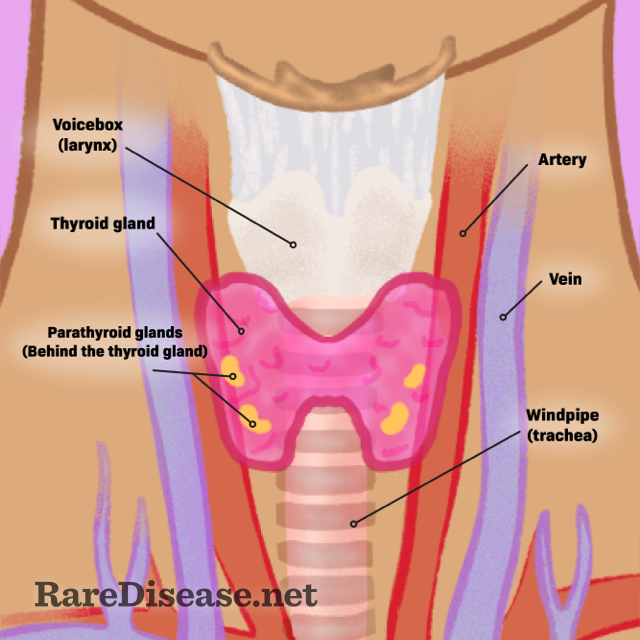How Is Hypoparathyroidism Treated?
Reviewed by: HU Medical Review Board | Last reviewed: March 2024 | Last updated: April 2024
The parathyroid glands are small glands located in the neck next to the thyroid glands. You have 4 of them and they are pea-sized. These glands make parathyroid hormone (PTH). PTH plays an important role in creating the right levels of blood calcium, phosphorus, and vitamin D in the body.1-3
Hypoparathyroidism is a rare disorder in which the body does not make enough PTH. Without enough PTH, many systems of the body may not work well. Hypoparathyroidism may cause mild, treatable symptoms:1,2,4
- Tingling or burning in the fingers, toes, and lips
- Muscle cramps, twitching, or spasms
- Fatigue and brain fog
- Painful menstrual periods
- Patchy hair loss
- Dry skin
- Brittle nails
- Depression or anxiety
Parathyroid glands lie just behind the thyroid gland in the neck

Severe hypoparathyroidism or milder forms that go untreated cause more serious, damaging symptoms such as:2,4,5
- Cataracts
- Heart problems like irregular heartbeats, low blood pressure, or heart failure
- Kidney stones or kidney damage
- Breathing problems
- Dental problems
- Growth problems
- Skeletal problems
- Balance and movement problems
- Seizures
Hypoparathyroidism may be temporary or a long-term (chronic) condition. Symptoms may be mild to severe, depending on how much PTH your body makes. Some symptoms can be reversed with treatment.2-4
Causes of hypoparathyroidism
There are 4 reasons why people develop hypoparathyroidism:2
- Surgery to the thyroid or neck that impacts nearby parathyroid glands
- Autoimmune diseases that attack the parathyroid
- Genetic disorders that affect parathyroid development
- Radiation to the neck
- Certain diseases impacting the parathyroid gland
Surgery is the most common cause of hypoparathyroidism, followed by autoimmune disease and genetic disorders that affect parathyroid development. Radiation to the neck and other diseases are the least common.2
DiGeorge syndrome is a rare condition in which a child is born without any parathyroid glands. It is usually diagnosed in childhood and includes other health problems besides hypoparathyroidism.4
There are treatments to manage chronic hypoparathyroidism but no cure. Some forms of temporary hypoparathyroidism may be reversed with treatment.2
Treatment for hypoparathyroidism
The treatment for hypoparathyroidism depends on what is causing low PTH and how severe the symptoms are. The goals of treatment are to:2,4
- Relieve symptoms
- Raise and maintain blood calcium levels in the normal range
- Prevent kidney stones
- Prevent more serious complications like seizures, heart failure, or breathing problems
People with hypoparathyroidism may be given a variety of medicines and supplements. Treatment varies from person to person depending on their age and the severity of their symptoms:2,5-8
- Calcium, vitamin D, or magnesium supplements
- Calcitriol (Rocaltrol®)
- Thiazide diuretics
- Calcium gluconate (Cal-Glu)
- Calcium citrate (Cal-Citrate™, Calcitrate®)
- Calcium glubionate
- Alfacalcidol
- Dihydrotachysterol (DHT, DHT Intensol™, Hytakerol)
- Recombinant human PTH – teriparatide (Forteo®)
People with hypoparathyroidism need regular blood and urine tests to monitor their blood calcium and phosphorus levels. This allows your doctor to increase and lower your medicines as your levels change. At first, this may mean weekly or monthly tests. Eventually, this may change to tests twice a year. Most people need testing and treatment for life.5
Diet changes
If you have hypoparathyroidism, your doctor may recommend you work with a dietitian. The dietitian will help you plan a diet that is rich in calcium and low in phosphorus.4,5
- Foods rich in calcium include dairy, green leafy vegetables, broccoli, and foods made with added calcium. Some orange juices and breakfast cereals are examples.
- Foods high in phosphorus include soft drinks, some processed foods, meats, hard cheeses, nuts, and whole grains. You may need to avoid or limit these foods when you eat.
Pregnancy and breastfeeding
People who are pregnant need extra monitoring during pregnancy and after delivery. Pregnancy and breastfeeding cause blood calcium levels to change, sometimes dramatically. Your doctor may need to adjust your medicines accordingly. PTH and calcium levels generally return to prepregnancy levels after the baby is weaned.2
Outcomes are good for people with hypoparathyroidism if it is diagnosed and treated early. However, children who go undiagnosed may face long-term complications that cannot be reversed.4